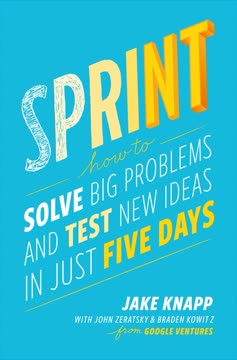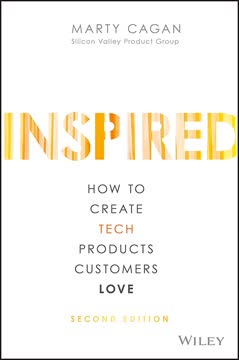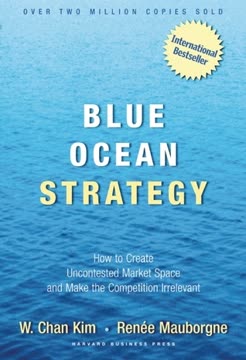가지 주요 요점
1. 디자인 사고는 문제 해결과 혁신을 위한 체계적인 접근 방식입니다
디자인 사고는 TQM이 품질을 위해 했던 것처럼 유기적 성장과 혁신을 위해 할 수 있습니다. 즉, 우리가 항상 중요하게 여겼던 것을 실현하기 위해 관리자들에게 도구와 프로세스를 제공하는 것입니다.
디자인 사고의 신비를 풀다. 디자인 사고는 마법이 아니며 디자이너에게만 국한된 것이 아닙니다. 이는 모든 관리자들이 접근할 수 있는 체계적인 문제 해결 접근 방식입니다. 고객을 깊이 이해하고 그들을 위한 더 나은 미래를 창조하는 것으로 시작하며, 첫 시도가 완벽하지 않을 수 있음을 인정합니다.
디자인 사고의 주요 원칙:
- 공감: 고객의 필요와 경험을 깊이 이해하기
- 발명: 그 필요를 충족시키기 위한 새로운 해결책 창출
- 반복: 피드백과 학습을 바탕으로 아이디어를 지속적으로 개선하기
디자인 사고는 전통적인 비즈니스 분석을 보완하며, 인간 중심의 창의적인 접근 방식을 혁신에 도입합니다. 이는 관리자들이 점진적인 개선을 넘어 획기적인 성장 기회를 창출할 수 있도록 돕습니다.
2. 디자인 프로세스는 네 가지 주요 질문을 따릅니다: 무엇이 있는가? 만약 무엇이 있다면? 무엇이 놀라운가? 무엇이 작동하는가?
디자인은 공감으로 시작하며, 우리가 디자인하는 사람들을 깊이 이해하는 것으로 시작합니다.
네 가지 질문 프레임워크. 디자인 사고 프로세스는 각기 중요한 질문을 중심으로 한 네 가지 주요 단계로 나눌 수 있습니다:
- 무엇이 있는가? - 현재의 현실을 탐구하고 이해하기
- 만약 무엇이 있다면? - 새로운 가능성과 대안을 상상하기
- 무엇이 놀라운가? - 가장 유망한 개념을 식별하기
- 무엇이 작동하는가? - 실제 세계에서 아이디어를 테스트하고 개선하기
이 프레임워크는 혁신 프로젝트를 위한 명확한 로드맵을 제공하여 팀이 해결책으로 뛰어들기 전에 문제 공간을 철저히 탐구하도록 보장합니다. 이는 발산적 사고(많은 옵션 생성)와 수렴적 사고(최고의 아이디어로 좁히기)를 균형 있게 조화시킵니다.
3. 시각화와 여정 매핑은 깊은 고객 통찰력을 제공합니다
여정 매핑은 관찰과 인터뷰를 통해 수집된 데이터를 바탕으로 고객의 현재 경험을 안내합니다.
고객의 눈으로 보기. 시각화 기법은 팀이 고객 경험에 대한 복잡한 정보를 포착하고 전달하는 데 도움을 줍니다. 특히 여정 매핑은 감정의 고저를 포함한 전체 고객 경험을 이해하는 데 강력한 도구를 제공합니다.
주요 시각화 기법:
- 고객 여정 지도
- 페르소나
- 공감 지도
- 스토리보드
- 사진 및 비디오 민족지학
이 도구들은 팀이 고객에 대한 공감을 개발하고, 고통 지점과 기회를 식별하며, 조직 내에서 통찰력을 효과적으로 전달하는 데 도움을 줍니다. 이는 후속 단계에서 혁신적 사고를 촉진하는 공유된 이해를 제공합니다.
4. 브레인스토밍과 개념 개발은 혁신적인 해결책을 생성합니다
새로운 개념을 창출하는 것은 창의성보다는 규율에 더 많이 의존합니다.
구조화된 아이디어 생성. 효과적인 브레인스토밍은 단순한 자유형 아이디어 생성 이상을 요구합니다. 이는 신중한 준비, 명확한 기본 규칙, 아이디어를 포착하고 발전시키는 구조화된 접근 방식을 요구합니다.
성공적인 브레인스토밍의 주요 요소:
- 다양한 팀 구성
- 명확한 문제 설정
- 사고를 자극하는 질문
- 다른 사람의 아이디어를 발전시키기
- 초기에는 양보다 질
개념 개발은 브레인스토밍의 원시 출력을 일관되고 완전한 해결책 개념으로 변환합니다. 이는 관련 아이디어를 클러스터링하고, 주제를 식별하며, 요소를 결합하여 디자인 기준에 따라 평가할 수 있는 견고한 제안을 만드는 것을 포함합니다.
5. 가정 테스트와 빠른 프로토타이핑은 아이디어를 효율적으로 개선합니다
프로토타이핑은 학습의 가치를 계산하는 저비용 손실 계산을 사용합니다.
빠르고 저렴하게 배우기. 가정 테스트는 팀이 새로운 개념을 만들거나 깨뜨릴 수 있는 중요한 미지의 요소를 식별하는 데 도움을 줍니다. 가정을 명시적으로 설정하고 이를 테스트하기 위한 실험을 설계함으로써, 팀은 상당한 자원을 투자하기 전에 아이디어를 빠르게 검증하거나 무효화할 수 있습니다.
빠른 프로토타이핑은 개념을 빠르고 저렴하게 실현합니다. 주요 원칙은 다음과 같습니다:
- 간단하게 시작하기 (예: 종이 프로토타입)
- 완벽이 아닌 학습에 집중하기
- 피드백을 바탕으로 빠르게 반복하기
- 전체 개념뿐만 아니라 특정 요소 테스트하기
이 접근 방식은 팀이 여러 옵션을 탐색하고, 빠르게 실패하며, 실제 피드백을 바탕으로 아이디어를 개선할 수 있도록 하여 나중에 대규모 실패의 위험을 크게 줄입니다.
6. 고객 공동 창조와 학습 런치는 시장에서 개념을 검증합니다
낯선 개념을 도입할 때는 대부분 잘못될 가능성이 큽니다. 그렇기 때문에 저비용, 저충실도 프로토타입을 사용하는 공동 창조가 성공적인 혁신의 속도를 높이고 위험을 줄이는 데 필수적입니다.
고객과의 협력. 공동 창조는 잠재 고객을 새로운 제공물 개발에 참여시키는 것을 포함합니다. 이 협력적 접근 방식은 해결책이 진정으로 고객의 필요를 충족시키고 초기 단계에서 참여를 구축하도록 보장합니다.
학습 런치는 유망한 개념을 실제 시장에서 테스트합니다. 주요 원칙:
- 명확한 학습 목표 설정
- 성공 지표를 사전에 정의하기
- 시간, 지리 또는 고객 세그먼트 제한하기
- 빠른 피드백 주기를 설계하기
- 결과에 따라 반복하거나 피벗할 준비하기
이러한 접근 방식은 개념과 전체 규모의 출시 사이의 격차를 메우며, 주요 투자가 이루어지기 전에 중요한 데이터를 제공하여 진행 여부 결정을 내리고 제공물을 개선할 수 있도록 합니다.
7. 디자인 사고를 구현하려면 신중한 팀 선택과 모멘텀 관리가 필요합니다
프로젝트가 순조롭게 진행되고 사람들이 생산적이라고 느끼는 한, 긍정적인 분위기가 형성됩니다. 모멘텀을 구축하는 가장 중요한 요소는 속도입니다.
성공을 위한 구축. 조직에서 디자인 사고를 구현하려면 도구와 프로세스를 배우는 것 이상이 필요합니다. 이는 팀 구성, 프로젝트 선택, 모멘텀 유지에 대한 신중한 주의를 요구합니다.
성공적인 구현을 위한 주요 고려 사항:
- 관리 가능한 프로젝트로 작게 시작하기
- 다양한 기능을 가진 팀 선택
- 경영진의 후원 확보
- 전용 프로젝트 공간 ("전쟁실") 만들기
- 정기적인 체크인과 명확한 의사 결정 프로세스 설정
- 작은 승리와 실패로부터의 학습을 축하하기
이 요소들에 집중함으로써, 조직은 디자인 사고가 번창할 수 있는 환경을 조성하여 지속적인 혁신과 성장을 이끌어낼 수 있습니다.
마지막 업데이트 날짜:
FAQ
What's "Designing for Growth" about?
- Design Thinking for Managers: "Designing for Growth" by Jeanne Liedtka and Tim Ogilvie is a guide for managers on how to apply design thinking to drive business growth.
- Toolkit Approach: The book provides a toolkit of ten design thinking tools that managers can use to innovate and solve complex business problems.
- Structured Process: It outlines a structured process involving four key questions: What is? What if? What wows? and What works? to guide managers through the design thinking journey.
- Practical Examples: The book includes real-world examples and case studies to illustrate how design thinking can be applied in various business contexts.
Why should I read "Designing for Growth"?
- Practical Application: It offers practical tools and methods that managers can directly apply to their work to foster innovation and growth.
- Structured Framework: The book provides a clear, structured framework for implementing design thinking, making it accessible even to those new to the concept.
- Real-World Success Stories: It includes success stories from companies like AARP and Kaiser Permanente, demonstrating the effectiveness of design thinking in real business scenarios.
- Enhance Problem-Solving Skills: Reading this book can enhance your problem-solving skills by teaching you how to approach challenges creatively and strategically.
What are the key takeaways of "Designing for Growth"?
- Four Key Questions: The design thinking process is structured around four questions: What is? What if? What wows? and What works? These guide the exploration, ideation, and implementation phases.
- Ten Essential Tools: The book introduces ten tools, such as journey mapping and rapid prototyping, that are essential for applying design thinking in business.
- Customer-Centric Approach: Emphasizes the importance of understanding customer needs and involving them in the design process to create value.
- Iterative Learning: Encourages an iterative approach to innovation, where assumptions are tested and refined through prototypes and customer feedback.
How does "Designing for Growth" define design thinking?
- Systematic Approach: Design thinking is defined as a systematic approach to problem-solving that starts with understanding customer needs and creating a better future for them.
- Empathy, Invention, Iteration: It involves empathy for the user, invention of new solutions, and iteration to refine those solutions.
- Beyond Aesthetics: The book differentiates design thinking from traditional design by focusing on business growth and problem-solving rather than just aesthetics.
- Accessible to Managers: It argues that design thinking can be taught to managers and applied in business contexts to drive innovation.
What are the four key questions in "Designing for Growth"?
- What is?: This question focuses on understanding the current reality and identifying the real problem or opportunity.
- What if?: This stage involves envisioning new possibilities and generating creative ideas for the future.
- What wows?: Here, the focus is on selecting the most promising ideas that have the potential to create significant value.
- What works?: This final stage involves testing the ideas in the marketplace to see which ones are viable and can be scaled.
What are the ten tools of design thinking in "Designing for Growth"?
- Visualization: Using imagery to envision possibilities and bring them to life.
- Journey Mapping: Assessing the existing experience through the customer's eyes.
- Value Chain Analysis: Evaluating the current value chain that supports the customer's journey.
- Mind Mapping: Generating insights from exploration activities and creating design criteria.
- Brainstorming: Generating new possibilities and alternative business models.
- Concept Development: Assembling innovative elements into a coherent solution.
- Assumption Testing: Isolating and testing key assumptions that will drive success.
- Rapid Prototyping: Expressing a new concept in a tangible form for exploration.
- Customer Co-Creation: Involving customers in creating the solution that best meets their needs.
- Learning Launch: Creating an affordable experiment to test key assumptions with market data.
How does "Designing for Growth" suggest using visualization?
- Mother of All Tools: Visualization is considered a fundamental tool used in every stage of the design thinking process.
- Reduces Misinterpretation: It helps reduce project risk by making ideas tangible and reducing the chances of misinterpretation.
- Engages Right Brain: Visualization engages the right brain, which is responsible for emotion and intuition, aiding in decision-making.
- Various Forms: It can take many forms, including storyboards, sketches, and personas, to help communicate ideas effectively.
What is journey mapping according to "Designing for Growth"?
- Customer Experience Focus: Journey mapping is about representing the customer's experience in a flowchart or graphic format.
- Identifies Pain Points: It helps identify emotional highs and lows in the customer's journey, revealing opportunities for improvement.
- Empathy Building: By walking in the customer's shoes, it builds empathy and a deeper understanding of their needs.
- Foundation for Innovation: It serves as a foundation for generating innovative ideas that enhance the customer experience.
How does "Designing for Growth" recommend conducting brainstorming?
- Structured Process: Brainstorming should be a structured process with clear ground rules to encourage creativity and prevent critiques.
- Diverse Group: Involves a small, diverse group of people to bring in different perspectives and ideas.
- Trigger Questions: Uses trigger questions to stimulate creative thinking and explore new possibilities.
- Follow-Up: Emphasizes the importance of follow-up to convert raw ideas into robust concepts through concept development.
What is assumption testing in "Designing for Growth"?
- Key Assumptions: Assumption testing involves identifying and testing the key assumptions underlying a new business concept.
- Thought Experiments: It uses thought experiments to test assumptions with existing data before moving to market tests.
- Reduces Risk: By focusing on critical assumptions, it reduces the risk of failure by ensuring that only viable concepts move forward.
- Iterative Process: It is an iterative process that helps refine concepts and improve their chances of success.
How does "Designing for Growth" define rapid prototyping?
- Express Concepts: Rapid prototyping is about creating visual or experiential manifestations of concepts to test and refine them.
- Iterative Learning: It is an iterative process that allows for quick learning and refinement of ideas.
- Low-Fidelity Start: Prototypes start as low-fidelity models to invite feedback and collaboration from stakeholders.
- Minimizes Investment: By testing concepts early, it minimizes investment and risk before full-scale development.
What are the best quotes from "Designing for Growth" and what do they mean?
- "Design thinking is actually a systematic approach to problem solving." This quote emphasizes that design thinking is not just about creativity but involves a structured process to address business challenges.
- "Empathy, invention, and iteration." These three words capture the essence of design thinking, highlighting the importance of understanding users, creating new solutions, and refining them through feedback.
- "Fail fast to succeed sooner." This quote underscores the value of rapid prototyping and learning from failures quickly to achieve success in innovation.
- "Visualization is the mother of all design tools." It highlights the critical role of visualization in making ideas tangible and facilitating communication and collaboration.
리뷰
Designing for Growth는 평균 평점 5점 만점에 3.99점을 받으며 다양한 평가를 받고 있다. 독자들은 이 책의 시각적 매력과 디자인 사고 개념의 도입을 높이 평가하며, 초보자에게 유용하다고 생각한다. 일부는 실용적인 도구와 사례 연구를 칭찬하는 반면, 다른 이들은 표면적인 설명과 전문가에게는 깊이가 부족하다고 비판한다. 책의 구조와 조직적인 개요는 대체로 호평을 받는다. 그러나 일부 독자들은 책이 반복적이고 지나치게 기업적이라고 느낀다. 비영어권 번역의 품질은 자주 비판을 받는다. 전반적으로, 디자인 사고에 처음 입문하는 사람들에게 좋은 입문서로 간주된다.
Similar Books














